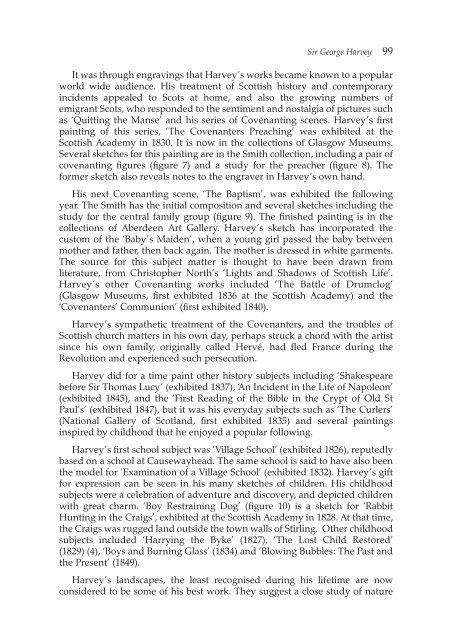the Forth Naturalist Historian - Forth Naturalist and Historian ...
the Forth Naturalist Historian - Forth Naturalist and Historian ...
the Forth Naturalist Historian - Forth Naturalist and Historian ...
You also want an ePaper? Increase the reach of your titles
YUMPU automatically turns print PDFs into web optimized ePapers that Google loves.
Sir George Harvey 99<br />
It was through engravings that Harvey’s works became known to a popular<br />
world wide audience. His treatment of Scottish history <strong>and</strong> contemporary<br />
incidents appealed to Scots at home, <strong>and</strong> also <strong>the</strong> growing numbers of<br />
emigrant Scots, who responded to <strong>the</strong> sentiment <strong>and</strong> nostalgia of pictures such<br />
as ‘Quitting <strong>the</strong> Manse’ <strong>and</strong> his series of Covenanting scenes. Harvey’s first<br />
painting of this series, ‘The Covenanters Preaching’ was exhibited at <strong>the</strong><br />
Scottish Academy in 1830. It is now in <strong>the</strong> collections of Glasgow Museums.<br />
Several sketches for this painting are in <strong>the</strong> Smith collection, including a pair of<br />
covenanting figures (figure 7) <strong>and</strong> a study for <strong>the</strong> preacher (figure 8). The<br />
former sketch also reveals notes to <strong>the</strong> engraver in Harvey’s own h<strong>and</strong>.<br />
His next Covenanting scene, ‘The Baptism’, was exhibited <strong>the</strong> following<br />
year. The Smith has <strong>the</strong> initial composition <strong>and</strong> several sketches including <strong>the</strong><br />
study for <strong>the</strong> central family group (figure 9). The finished painting is in <strong>the</strong><br />
collections of Aberdeen Art Gallery. Harvey’s sketch has incorporated <strong>the</strong><br />
custom of <strong>the</strong> ‘Baby’s Maiden’, when a young girl passed <strong>the</strong> baby between<br />
mo<strong>the</strong>r <strong>and</strong> fa<strong>the</strong>r, <strong>the</strong>n back again. The mo<strong>the</strong>r is dressed in white garments.<br />
The source for this subject matter is thought to have been drawn from<br />
literature, from Christopher North’s ‘Lights <strong>and</strong> Shadows of Scottish Life’.<br />
Harvey’s o<strong>the</strong>r Covenanting works included ‘The Battle of Drumclog’<br />
(Glasgow Museums, first exhibited 1836 at <strong>the</strong> Scottish Academy) <strong>and</strong> <strong>the</strong><br />
‘Covenanters’ Communion’ (first exhibited 1840).<br />
Harvey’s sympa<strong>the</strong>tic treatment of <strong>the</strong> Covenanters, <strong>and</strong> <strong>the</strong> troubles of<br />
Scottish church matters in his own day, perhaps struck a chord with <strong>the</strong> artist<br />
since his own family, originally called Hervé, had fled France during <strong>the</strong><br />
Revolution <strong>and</strong> experienced such persecution.<br />
Harvey did for a time paint o<strong>the</strong>r history subjects including ‘Shakespeare<br />
before Sir Thomas Lucy’ (exhibited 1837), ‘An Incident in <strong>the</strong> Life of Napoleon’<br />
(exhibited 1845), <strong>and</strong> <strong>the</strong> ‘First Reading of <strong>the</strong> Bible in <strong>the</strong> Crypt of Old St<br />
Paul’s’ (exhibited 1847), but it was his everyday subjects such as ‘The Curlers’<br />
(National Gallery of Scotl<strong>and</strong>, first exhibited 1835) <strong>and</strong> several paintings<br />
inspired by childhood that he enjoyed a popular following.<br />
Harvey’s first school subject was ‘Village School’ (exhibited 1826), reputedly<br />
based on a school at Causewayhead. The same school is said to have also been<br />
<strong>the</strong> model for ‘Examination of a Village School’ (exhibited 1832). Harvey’s gift<br />
for expression can be seen in his many sketches of children. His childhood<br />
subjects were a celebration of adventure <strong>and</strong> discovery, <strong>and</strong> depicted children<br />
with great charm. ‘Boy Restraining Dog’ (figure 10) is a sketch for ‘Rabbit<br />
Hunting in <strong>the</strong> Craigs’, exhibited at <strong>the</strong> Scottish Academy in 1828. At that time,<br />
<strong>the</strong> Craigs was rugged l<strong>and</strong> outside <strong>the</strong> town walls of Stirling. O<strong>the</strong>r childhood<br />
subjects included ‘Harrying <strong>the</strong> Byke’ (1827), ‘The Lost Child Restored’<br />
(1829) (4), ‘Boys <strong>and</strong> Burning Glass’ (1834) <strong>and</strong> ‘Blowing Bubbles: The Past <strong>and</strong><br />
<strong>the</strong> Present’ (1849).<br />
Harvey’s l<strong>and</strong>scapes, <strong>the</strong> least recognised during his lifetime are now<br />
considered to be some of his best work. They suggest a close study of nature



